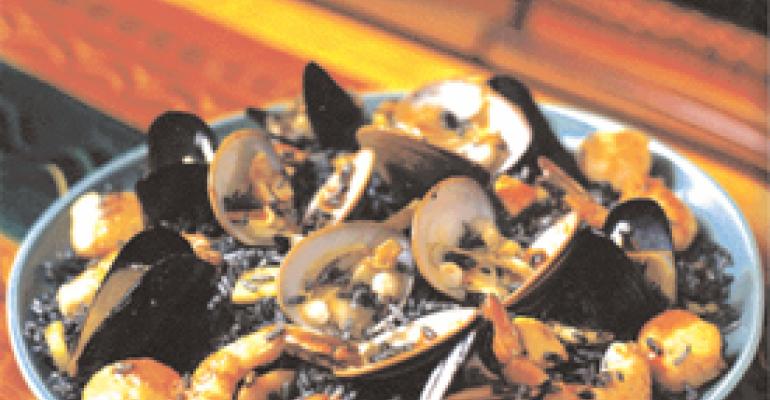Few seafood favorites bring to mind the taste of the sea as much as mussels, the versatile bivalves that many Americans have come to love as much as Southern Europeans and other seaside dwellers have for centuries.
Rick Kimmes, executive chef-partner at the original Oceanaire Seafood Room in Minneapolis, is a big fan of mussels, which he prepares in the traditional French fashion, simply steamed with white wine, butter, green onion, shallots and garlic. He serves them in a large bowl with toasted bread for dipping.
“I look at it in awe sometimes,” Kimmes says. “Just the smell of those things is so wonderful.”
Because the consistency of farm-raised mussels is so reliable, they are reasonably priced, allowing restaurants to pass on the cost savings to customers. Oceanaire charges $10.95 for a bowl full of mussels weighing a pound or two, Kimmes says.
Spanish and Portuguese influences often enter into mussels dishes and usually include spicy chorizo sausage in the combination. Chef Sam Putnam at Ashmont Grill in Dorchester, Mass., often features steamed mussels with finely diced Spanish chorizo, onions, sweet peppers, smoked paprika, garlic, rosemary and tomatoes. He finishes the dish with garlic butter.
“We use five or six different preparations, but this is the most popular,” Putnam says. “People really like the smokiness of the sausage with the sweetness of the mussels.”
A bit of chorizo also makes its way into a Portguese-influenced appetizer at Niche Restaurant in Geneva, Ill. Chef Jeremy Lycan steams Prince Edward Island farmed mussels, a popular kind among chefs interviewed, in a roasted tomato broth with cilantro. Grilled house-made sourdough bread for dipping accompanies the dish.
Chefs who use the farmed varieties say they are more consistent and cleaner than wild-caught mussels, requiring less labor in the kitchen.
Hola! Tapas Bar in Dallas bases one of its small-plate mussel dishes on a recipe from Catalan, Spain. Owner Ildefonso Jimenez adds mussels and white wine to a slowly simmered sauce containing tomatoes, onions, garlic, oregano, tarragon, garlic, cumin, saffron and a dried Spanish hot pepper. He steams the mussels in the sauce just until they open.
At the Mediterranean-theme Lauro Kitchen in Portland, Ore., chef David Machado features black Mediterranean mussels from Washington and British Columbia in cataplana, a lidded Portuguese steamer that goes both on the stovetop and in the oven.
Machado cooks onions with red and yellow bell peppers, Portuguese sausage, garlic, chopped tomatoes, white wine, herbs and spices. He spoons some of the sauce into the bottom of the cataplana and places the mussels on top with more sauce and a splash of wine. He simmers and then oven-roasts the mixture, adding chopped cilantro just before serving.
Moving to New World influences, Richard Sandoval says he loves mussels and uses them in many ways at his nine Latin-inspired restaurants. He prefers wild-caught East Coast mussels over farm-raised because, he says, “they have more flavor, and they smell and taste of the ocean more in the broth.”
One of his favorite dishes, served at Pompano and Maya in New York, is mariscada, his interpretation of paella. The black-rice-based dish contains mussels, scallops, shrimp and clams with roasted garlic purée and achiote.
Mexican flavors appear at Red Rock Bistro in Swampscott, Mass., in executive chef Lee Fannon’s dish with tomatillos, jalapeño, garlic, lime juice, cilantro, oregano and a light Mexican beer. He garnishes the dish with plantain chips. Fannon says the spicy ingredients bring out the sweetness of the mussels and nicely balance the flavors.
Asian accents also marry well with mussels. A yellow-curry broth accompanies the mussels at the Chicago locations of Portland, Ore.-based McCormick & Schmick’s. Mike Sullivan, executive chef, uses wild-caught mussels from the Boston area when available or farmed when they’re not. The dish is available for $11.90.
Alex Cheswick at May Street Market in Chicago also likes Asian flavors with his mussels. One of his signature appetizers is a presentation of two bowls, with one containing the steamed mussels and the other a soup of coconut milk, lemon grass and carrot.
Steve Gontram, chef-owner of Harvest in St. Louis, roasts mussels in an iron skillet with a dash of kosher salt and garlic oil. He serves them sizzling hot in the skillet.
Mussels also can be served cold as they are at Café Matou in the summer in chef Charlie Socher’s mussels salad. The mussels are served on a bed of four herbs, red bell pepper and yellow tomato with a light citrus, garlic and extra virgin olive oil dressing. The dish sells for $10.25.
Other chefs also have come up with light, refreshing ways to feature mussels this season. Carrie VanDyck, owner of The Herbfarm in Woodinville, Wash., is serving them skewered on rosemary stems. She pan-sears the shelled, skewered mussels over basil “wood” and serves them with marjoram aïoli. The seasonal-regional restaurant buys farmed mussels from Penn Cove and Westcott Bay in the Puget Sound.
With a focus on local farmers market herbs and produce, Bin 36 in Chicago serves mussels with a Riesling and golden-beet broth, fava beans and mint for $11.50. The fava beans add color and texture, notes executive chef John Caputo.
“We keep some sort of mussel dish on all the time,” he says. “We’ve tried to substitute steamed clams, but Chicagoans don’t accept clams as much as mussels.”

